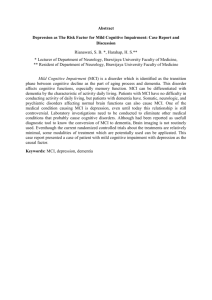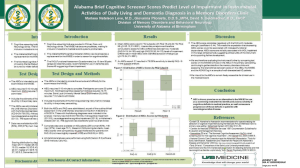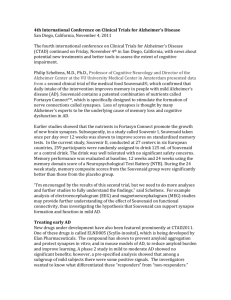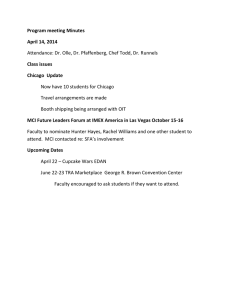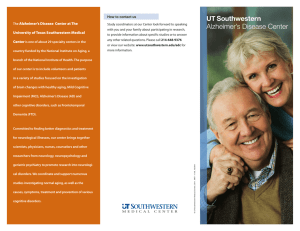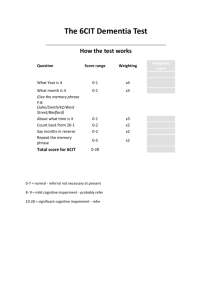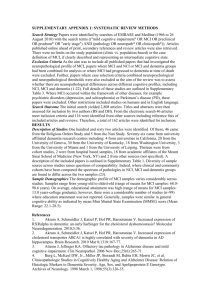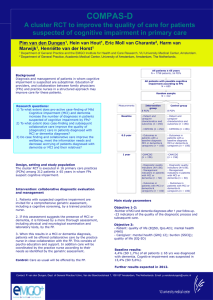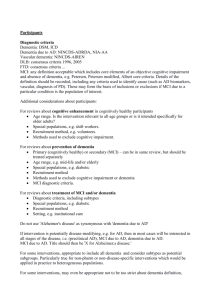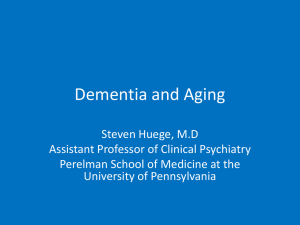Preventing Alzheimer’s Disease & Related Disorders: William Rodman Shankle, MS MD
advertisement
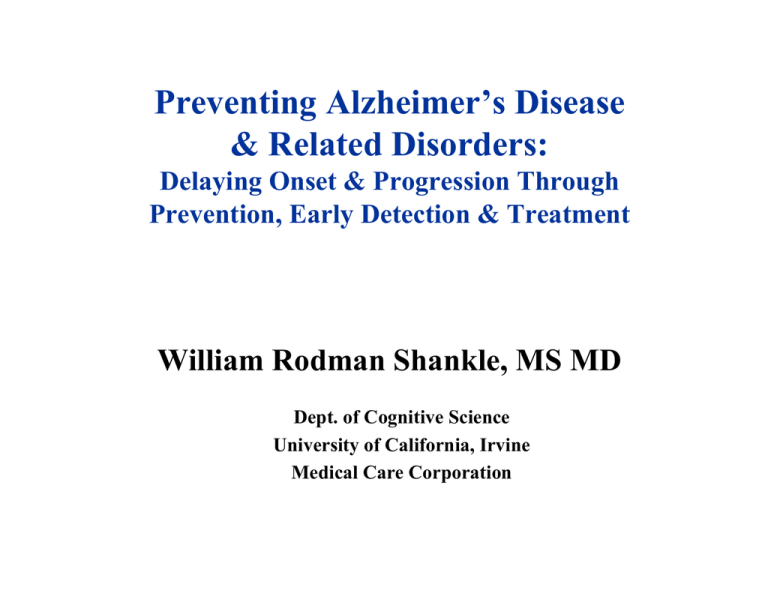
Preventing Alzheimer’s Disease & Related Disorders: Delaying Onset & Progression Through Prevention, Early Detection & Treatment William Rodman Shankle, MS MD Dept. of Cognitive Science University of California, Irvine Medical Care Corporation The Importance of Early Detection, Diagnosis and Treatment The AD Timeline: Functional Assessment Staging Test USA: A. 3.1 Million Have Detected AD B. 3.1 Million Have AD Not Yet Detected (FAST 2-4) C. 6.2 Million Have AD in Total Moderate Dementia: FAST Stages 5-6: lose basic ADLs Mild Dementia: FAST Stage 4: lose complex ADLs Severe Dementia: FAST Stage 7: lose speech, gait, posture Mild Cog. Imp.: FAST Stages 2-3 No Symptoms: FAST Stage 1 -30 0 7 9 11 18 35 65 72 74 76 82 if prevention started here, Cost Per Claim: $17,400/patient Total USA Claims Cost: $54.4 Billion if first detected here, $71,100/patient. $222.6 Billion >2/3 first detected here, $142,000/LTC claim $444.2 Billion The Impact of Treatment of Alzheimer’s Disease CheI Treatment Delays NHP: Effects of Rx Duration and Early Rx Dementia Severity at Rx Onset (FAST) Median Time to NHP (Yrs) 5 5 5 4 4 6 5 4 4.5 4 5.3 5 A 2-3+ year delay 3 2 2 1 0 0 0.5 1 1 2 Duration of Treatment (Years) Knopman D, et al. Neurology. 1996;47:166-177. Geldmacher et al., J Am Geriatr Soc. 2003; 51: 937-44 Early Dx & Rx of Alzheimer’s Disease Reduces Total Disease Costs $40,000 Average Annual Cost Per Patient ¾ Physician & ER visits (2X non-demented)1 ¾ Hospitalization ($4000 more/hosptlztn)1,2 ¾ Medications ($3,000 more for comorbidities)1,3 ¾ Long-term care: $56K/yr (4X cost of home care)2 ¾ Medicare Costs are 1.6 times that of non-demented patients4 ¾ Early Detection & Rx Can Reduce These Costs By 17-44% 1 Doraiswamy PM, et al. Neurology. 1996;52(suppl 2):A126. 2 Torian LV, et al. Int Psychogeriatr. 1994;4:231-239. 3 Gutterman EM et al. J Am Geriatr Soc. 1999;47:1065-1071. 4 Taylor DH. Research and Practice in Alzheimer’s Disease. 2001. Vol. 5. Springer Pub.: 222-227 Preventing Alzheimer’s: Delaying Its Onset Factors Influencing Progression of Alzheimer’s Disease Neuropathology High Calories/Fat High Cholesterol Free Radicals Heart Disease Hypertension Beta Amyloid Genetics Trauma Antioxidants Statins Alcohol NSAIDs Cholinesterase Inhibitors Exercise The Science Behind Detecting Mild Cognitive Impairment The Mathematical Filter Developing The MCI Detection System Analyze CERAD Battery Select Sensitive Tests Choose Tests Most Sensitive for MCI vs Normal MCC DATABASE The CERAD Wordlist was the most sensitive test for purposes of early detection Developing The MCI Detection System Analyze CERAD Wordlist Correspondence Analysis Mathematically Separate Normal and MCI Performance: Row Score Data MCC DATABASE The Science Behind Detecting Mild Cognitive Impairment The Neural Modeling Filter Developing The MCI Detection System Examine The Strength of Encoding and Recalling or Not Recalling Each Word in Each Trial Column Scores MCC DATABASE Capture Processing of Episodic Memory in the Hippocampus Every Word Counts: Encoding Strength of Each Word In Each Trial Can Be Captured Encoding Strength of “Butter” if recalled for each of the four trials 5 Relative Strength of Word Per Trial Trial 1 Trial 2 Trial 3 Trial 4 3 1 -1 Butter Arm Shore Letter Queen Cabin Pole Encoding Deficit of “Butter” if not recalled for each of the four trials Ticket Grass Engine Developing The MCI Detection System Feed Filtered Data Into Discriminant Analysis Discriminant Analysis MCC DATABASE Classify as NL vs. Impaired Correspondence Analysis Of The CERAD Wordlist Item Scores Gives The Most Accurate Detection of Normal Aging and MCI CDRS Dementia Severity Class 0 Classification Accuracy (%) (Normal) 97% 0.5 (Mild Cognitive Impairment) 80% 0.5 (Mild Cognitive Impairment AD) 98% 0.5 (Mild Cognitive Impairment non-AD) 76% 1 98% (Mild Dementia) 2 (Moderate Dementia) 100% 3 (Severe Dementia) 100% If the screening result is normal, then the subject does not have AD If the result is impaired, then proceed with differential diagnosis and treatment Accuracy of MCI AD Detection For CERAD Wordlist Delayed Free Recall Compared to CERAD Wordlist Algorithm (MST: Mental Skills Test) 98% 100% 99% 97% 90% 80% CERAD DFR 70% MST Results: UCI ADRC 60% 60% 50% 40.0% 40% 30% 20% 10% 1.3% 3% 2% 0% Sensitivity For Impaired (TP) Specificity for Normal (TN) False Positives False Negatives Note: The best possible cutoff criteria for the CERAD Wordlist still misses ~40% of well diagnosed MCI AD cases Screening Accuracy in Normal Aging vs. Mild Cognitive Impairment 99% 98% 97% 97% SP 83% 78% 80% 97% 76% 44% on -A D ) D) (M CI N (M ST M ST M Screening Test CI A ST M l Lo r ig in a IS -T CW M T M D Q Co g Ca m D S TI C S CA M CA E Sh or t CO D 8 Q > T FA CD SI 20% IQ M M SE <2 5 M in i-C og 100% 88% 90% 80% 70% 60% 50% 40% 30% 30% 20% 10% 0% SN Only the MMSE, FAQ, TICS and CERAD Wordlist have published comparisons of accuracy for discriminating Mild Cognitive Impairment from Normal Aging The Science Behind Detecting Mild Cognitive Impairment The Clinical Filter Cognitive Cognitive Performance Impairment TRUE DFR == Impaired FALSE Patterns DCR == Impaired TRUE DCR == Impaired TRUE FALSE FALSE IRTOT == Impaired IRTOT == Impaired IRTOT == Impaired IRTOT == Impaired FALSE DCRNoZscore < -3.1 AND DCRNo <= 8 TRUE TRUE TRUE FALSE FALSE FALSE DCRYesZscore < -3.1 OR DCRYes <= 6 TRUE TRUE P1: ADWM N=233 Sens=100% P2: ADNoWM N=38 Sens=92% P3: SCWM N=65 Sens=95% P4: SCNoWM N=28 Sens=82% P5: FDCR N=12 Sens=83% P6: FDCRNo N=9 Sens=100% P7: DCRYes N=15 Sens=87% TRUE FALSE FALSE P8: NLDCR N=11 Sens=55% P9: FNoDCR N=38 Sens=79% P10: NLNoDCR N=204 Spec=54% Patterns of Cognitive Performance Further Characterize Normal & Impaired Applicants 99% 100% 90% 94% 96% 100% 99% 97% 97% 92% 90% 80% 69% 70% 60% 50% 40% 31% 30% 20% 10% 10% 1% 6% 4% 8% 0% 3% 3% 1% ta l To SC W M SC No W M FN oD CR FD C RN o DC RY es AD W M AD No W M NL N oD CR NL D CR 0% Cognitive Pattern Note: 4 cognitive performance patterns-ADWM, ADNoWM, SCNoWM and SCWM—have relatively more impaired subjects, and strongly suggest Alzheimer's Disease or Vascular Dementia. Mathematical, Clinical and Hippocampal Filters Combine to Form The Mental Skills Test To Detect Normal Aging vs. MCI No. of Subjects Sensitivity (Impaired) Specificity (Normals) Mental Skills Test: MCI AD vs. Normal 641 98% 97% Memory Screen: MCI vs. Normal 476 94% 80% InfoducerTM Early ADRD Detection Mental Skills Test • 98% Accurate • 8-10 Minutes • Office Staff gives test • Online 7/24 • Immediate Report (Pt+MD) Batchelder, Chosak, Shankle.. J Gerontology. 1997 Shankle et al., sbumitted PNAS, 2004 Comparison of Claims Costs of MCI AD Cases Not Detected Per 1,000 Applicants During Underwriting, and Issued a Long-Term Care Policy Current Method Correspondence Analysis (MST) $1 $(14,298) $(50,000.00) 0.10 of 5 MCI AD/1,000 Apps Not Detected $(100,000.00) $(150,000.00) 25% of 8500 early claimants had ADRD within 5 years of policy issue (were not detected by underwriting) $(200,000.00) $(250,000.00) $(300,000.00) $(285,956) 2.09 of 5 MCI AD/1,000 Apps Not Detected Better Detection of MCI AD Saves $272,000 Per 1,000 LTC Applicants Comparison of Claims Costs of Normal Cases Issued a Long-Term Care Policy Who Later Develop AD: Effect of Early Detection and Treatment $- Current Approach Early Detection & Treatment $0 $(2,000,000) $(4,000,000) $(6,000,000) 99 of 995 Normal Apps Will Develop AD Early Detection & Treatment Delays AD Progression 3-5 years $(8,000,000) $(10,000,000) Assumptions: 1. $150 Per Day For Skilled Nursing 2. Mean Duration For AD in SNF = 2.5 Years $(12,000,000) $(14,000,000) $13.6 Million Early Detection & Treatment AD Saves $13.6 Million Per 1,000 LTC Applicants The Mental Skills Test: Diverse Areas Tested Frontal Lobe • Behavior • Mood • Judgment • Processing Speed • Working Memory Temporal Lobe •Comprehension •Naming •Episodic Memory Parietal Lobe •Comprehension
